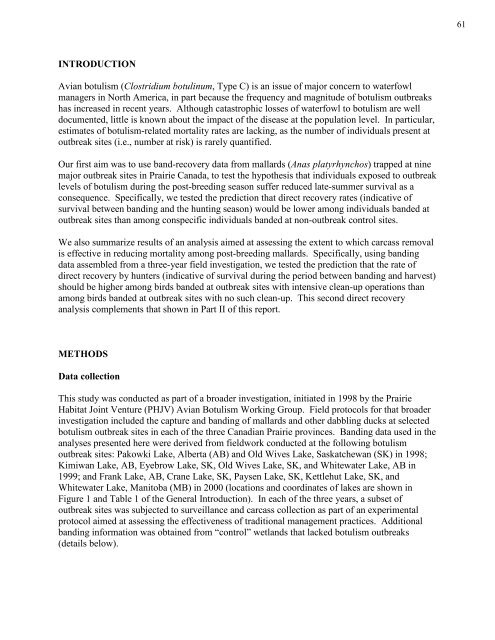Ecology and Management of Avian Botulism on the Canadian Prairies
Ecology and Management of Avian Botulism on the Canadian Prairies
Ecology and Management of Avian Botulism on the Canadian Prairies
You also want an ePaper? Increase the reach of your titles
YUMPU automatically turns print PDFs into web optimized ePapers that Google loves.
61INTRODUCTION<str<strong>on</strong>g>Avian</str<strong>on</strong>g> botulism (Clostridium botulinum, Type C) is an issue <str<strong>on</strong>g>of</str<strong>on</strong>g> major c<strong>on</strong>cern to waterfowlmanagers in North America, in part because <strong>the</strong> frequency <str<strong>on</strong>g>and</str<strong>on</strong>g> magnitude <str<strong>on</strong>g>of</str<strong>on</strong>g> botulism outbreakshas increased in recent years. Although catastrophic losses <str<strong>on</strong>g>of</str<strong>on</strong>g> waterfowl to botulism are welldocumented, little is known about <strong>the</strong> impact <str<strong>on</strong>g>of</str<strong>on</strong>g> <strong>the</strong> disease at <strong>the</strong> populati<strong>on</strong> level. In particular,estimates <str<strong>on</strong>g>of</str<strong>on</strong>g> botulism-related mortality rates are lacking, as <strong>the</strong> number <str<strong>on</strong>g>of</str<strong>on</strong>g> individuals present atoutbreak sites (i.e., number at risk) is rarely quantified.Our first aim was to use b<str<strong>on</strong>g>and</str<strong>on</strong>g>-recovery data from mallards (Anas platyrhynchos) trapped at ninemajor outbreak sites in Prairie Canada, to test <strong>the</strong> hypo<strong>the</strong>sis that individuals exposed to outbreaklevels <str<strong>on</strong>g>of</str<strong>on</strong>g> botulism during <strong>the</strong> post-breeding seas<strong>on</strong> suffer reduced late-summer survival as ac<strong>on</strong>sequence. Specifically, we tested <strong>the</strong> predicti<strong>on</strong> that direct recovery rates (indicative <str<strong>on</strong>g>of</str<strong>on</strong>g>survival between b<str<strong>on</strong>g>and</str<strong>on</strong>g>ing <str<strong>on</strong>g>and</str<strong>on</strong>g> <strong>the</strong> hunting seas<strong>on</strong>) would be lower am<strong>on</strong>g individuals b<str<strong>on</strong>g>and</str<strong>on</strong>g>ed atoutbreak sites than am<strong>on</strong>g c<strong>on</strong>specific individuals b<str<strong>on</strong>g>and</str<strong>on</strong>g>ed at n<strong>on</strong>-outbreak c<strong>on</strong>trol sites.We also summarize results <str<strong>on</strong>g>of</str<strong>on</strong>g> an analysis aimed at assessing <strong>the</strong> extent to which carcass removalis effective in reducing mortality am<strong>on</strong>g post-breeding mallards. Specifically, using b<str<strong>on</strong>g>and</str<strong>on</strong>g>ingdata assembled from a three-year field investigati<strong>on</strong>, we tested <strong>the</strong> predicti<strong>on</strong> that <strong>the</strong> rate <str<strong>on</strong>g>of</str<strong>on</strong>g>direct recovery by hunters (indicative <str<strong>on</strong>g>of</str<strong>on</strong>g> survival during <strong>the</strong> period between b<str<strong>on</strong>g>and</str<strong>on</strong>g>ing <str<strong>on</strong>g>and</str<strong>on</strong>g> harvest)should be higher am<strong>on</strong>g birds b<str<strong>on</strong>g>and</str<strong>on</strong>g>ed at outbreak sites with intensive clean-up operati<strong>on</strong>s thanam<strong>on</strong>g birds b<str<strong>on</strong>g>and</str<strong>on</strong>g>ed at outbreak sites with no such clean-up. This sec<strong>on</strong>d direct recoveryanalysis complements that shown in Part II <str<strong>on</strong>g>of</str<strong>on</strong>g> this report.METHODSData collecti<strong>on</strong>This study was c<strong>on</strong>ducted as part <str<strong>on</strong>g>of</str<strong>on</strong>g> a broader investigati<strong>on</strong>, initiated in 1998 by <strong>the</strong> PrairieHabitat Joint Venture (PHJV) <str<strong>on</strong>g>Avian</str<strong>on</strong>g> <str<strong>on</strong>g>Botulism</str<strong>on</strong>g> Working Group. Field protocols for that broaderinvestigati<strong>on</strong> included <strong>the</strong> capture <str<strong>on</strong>g>and</str<strong>on</strong>g> b<str<strong>on</strong>g>and</str<strong>on</strong>g>ing <str<strong>on</strong>g>of</str<strong>on</strong>g> mallards <str<strong>on</strong>g>and</str<strong>on</strong>g> o<strong>the</strong>r dabbling ducks at selectedbotulism outbreak sites in each <str<strong>on</strong>g>of</str<strong>on</strong>g> <strong>the</strong> three <strong>Canadian</strong> Prairie provinces. B<str<strong>on</strong>g>and</str<strong>on</strong>g>ing data used in <strong>the</strong>analyses presented here were derived from fieldwork c<strong>on</strong>ducted at <strong>the</strong> following botulismoutbreak sites: Pakowki Lake, Alberta (AB) <str<strong>on</strong>g>and</str<strong>on</strong>g> Old Wives Lake, Saskatchewan (SK) in 1998;Kimiwan Lake, AB, Eyebrow Lake, SK, Old Wives Lake, SK, <str<strong>on</strong>g>and</str<strong>on</strong>g> Whitewater Lake, AB in1999; <str<strong>on</strong>g>and</str<strong>on</strong>g> Frank Lake, AB, Crane Lake, SK, Paysen Lake, SK, Kettlehut Lake, SK, <str<strong>on</strong>g>and</str<strong>on</strong>g>Whitewater Lake, Manitoba (MB) in 2000 (locati<strong>on</strong>s <str<strong>on</strong>g>and</str<strong>on</strong>g> coordinates <str<strong>on</strong>g>of</str<strong>on</strong>g> lakes are shown inFigure 1 <str<strong>on</strong>g>and</str<strong>on</strong>g> Table 1 <str<strong>on</strong>g>of</str<strong>on</strong>g> <strong>the</strong> General Introducti<strong>on</strong>). In each <str<strong>on</strong>g>of</str<strong>on</strong>g> <strong>the</strong> three years, a subset <str<strong>on</strong>g>of</str<strong>on</strong>g>outbreak sites was subjected to surveillance <str<strong>on</strong>g>and</str<strong>on</strong>g> carcass collecti<strong>on</strong> as part <str<strong>on</strong>g>of</str<strong>on</strong>g> an experimentalprotocol aimed at assessing <strong>the</strong> effectiveness <str<strong>on</strong>g>of</str<strong>on</strong>g> traditi<strong>on</strong>al management practices. Additi<strong>on</strong>alb<str<strong>on</strong>g>and</str<strong>on</strong>g>ing informati<strong>on</strong> was obtained from “c<strong>on</strong>trol” wetl<str<strong>on</strong>g>and</str<strong>on</strong>g>s that lacked botulism outbreaks(details below).


